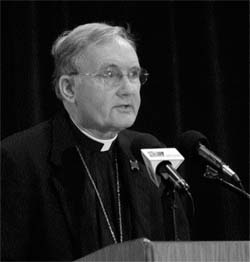Given the Chance to Come Clean on Sex Abuse, Bishop Brown Chokes—Again
By Gustavo Arellano
Orange County Weekly
March 4, 2004
[See also other articles by Gustavo Arellano.]
Bishop Tod D. Brown had his moment in the national spotlight, the chance to prove his reputation as a church reformer is more than just the marketing creation of a New York PR firm to whom the Diocese of Orange has paid $90,000.
Instead, Brown choked.
On Feb. 27, the ABC news show Nightline hosted the head of Orange County's 1.1 million Catholics as part of its coverage of a monumental report on priest-child sexual molestation within the American Catholic Church since 1950. The report, released that day by the New York-based John Jay Institute, revealed the names of priests who stand accused of sexually abusing minors. But here in the land of Father Junipero Serra, it's secrecy as usual. And now the whole country knows it.
 |
| Photo by James Bunoan |
After a brief lead-in showing Brown's infamous Jan. 18 Martin Luther rip-off
(during which he nailed his "Covenant with the Faithful" to
the door of Orange's Holy Family Cathedral), Nightline correspondent Ron
Claiborne went to business. He gave an excellent summary of the sex scandal
that has plagued Catholic Orange County—named names, interviewed
victims, even showed pictures of such notorious child rapists as John
Lenihan and Michael Harris. Halfway through the piece, Claiborne bluntly
asked Brown the question so many victims have asked for decades: Shouldn't
church leaders have known and done something about pedophilic priests?
Brown was quiet for a moment, furrowed his brow, and then said slowly,
deliberately, "I think you're correct." Then he fell silent.
The silence continued—an uncomfortable, disturbing silence that
might've lasted maybe seven seconds but felt like 28 years.
Offscreen, Claiborne was incredulous. "You said they should've
known?" he asked Brown.
Brown seemed to search for words. "It doesn't make sense," he
acknowledged, that diocesan officials had coddled criminals for so long.
"And I think that in the past, [the importance of transparency] wasn't
understood."
Brown still doesn't understand. Compare, for instance, an investigation
released Feb. 17 by the Archdiocese of Los Angeles with a similar one
issued by Orange County Catholic officials in early January. Both dioceses
conducted in-house studies of all accused child-molesting priests in their
respective histories for the John Jay Institute survey.
According to the Los Angeles report, 244 clergy members have faced accusations
of molesting 656 children since 1930—almost nine per year. The culprits
in the 28-year-old Orange diocese are substantially fewer: just 22 priests
have allegedly abused 53 children—almost two per year. If such conclusions
are correct, LA-area priests are roughly four times more likely to molest
kids than their colleagues down here.
Before you heave a sigh of relief and send your kids back to the overnight
camp with the parish youth pastor, consider the possibility that the Orange
County report is a sham.
The Archdiocese of Los Angeles announced its findings in a 34-page analysis
that includes: an introduction by archdiocese head Cardinal Roger Mahony;
an admission of guilt by church leaders for covering up decades of abuse;
a plea for forgiveness from the faithful; a thorough explanation of the
evolution of church policy regarding sexual abuse; and a description of
current civil and criminal cases pending against the archdiocese. Also
included is a roll call identifying every priest, brother, seminarian
or monk ever accused—name, years during which the alleged molestations
took place, and the number of accusers per priest (available at www.la-archdiocese.org).
Despite all that, victims' groups have called the LA archdiocese report
inadequate; in a Feb. 23 editorial, the Los Angeles Times said it was
old news. More damning, a supplement to the John Jay Institute study excoriated
LA Archdiocese head Cardinal Roger Mahony and his operation as "troubled."
Only the Orange assessment could make the LA report look good. Orange
County's report came in the form of a one-page press release naming just
16 priests accused of sex with minors. The names of the accused are bunched
together in one paragraph, one after another without explanation—no
corresponding years of service or number of accusers. No apology from
Brown. A subsequent Feb. 4 press release added six more priests to the
total; that fax came out to half a page.
In some ways, Los Angeles investigators even outperform Orange investigators
in covering the sex scandal in Orange County. Orange County Catholic churches
were under the jurisdiction of the Los Angeles archdiocese until 1976,
when the Vatican created the separate Diocese of Orange. To account for
this, Los Angeles archdiocesan researchers included 11 priests accused
of molestation who served in Orange County parishes before the 1976 separation;
Orange diocesan officials identify only six of these. The Los Angeles
report also lists four Orange County clergy members who weren't priests
but belonged to religious orders that served in the Orange diocese even
after the Orange diocese's founding; the Orange report lists none.
On the subject of such absolute fecklessness, Brown could tell Nightline's
audience nothing. Claiborne mercifully ended the segment, and the director
went back for a second time to video of Brown nailing to the church doors
his empty promise of reform. Brown's seven seconds of silence spoke more
eloquently.
Any original material on these pages is copyright © BishopAccountability.org 2004. Reproduce freely with attribution.